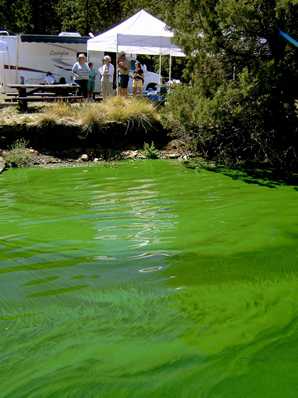Illness & Symptoms

HAB in Copco Lake in California. Credit: Photo courtesy of Lorrie Backer.
Harmful algal blooms (HABs) can produce toxins that can cause illness in people, companion animals (dogs, cats), livestock (sheep, cattle), and wildlife (including birds and mammals). Exposures to the toxins can occur when people or animals have direct contact with contaminated water by:
- Swimming
- Breathing in aerosols (tiny airborne droplets or mist that contain toxins) from recreational activities or wind-blown sea spray 1,2
- Swallowing toxins by drinking contaminated water or eating contaminated fish or shellfish 3.
Human and animal illnesses and symptoms can vary depending on the how they were exposed, how long they were exposed, and the particular HAB toxin involved.
Visit the following pages for more information on illness and symptoms associated with freshwater or marine environments.
For more information on how to reduce HAB-associated illnesses, please see Prevention & Control.
References
- Fleming L, Backer L, Rowan A. The epidemiology of human illnesses associated with harmful algal blooms. In: Massaro E, ed. Handbook of Neurotoxicology: Humana Press;2002:363-81.
- Kite-Powell HL, Fleming LE, Backer LC, Faustman EM, Hoagland P, Tsuchiya A, Younglove LR, Wilcox BA, Gast RJ. Linking the oceans to public health: current efforts and future directions. Environ Health. 2008;7(Suppl 2):S6.
- Van Dolah FM. Marine algal toxins: origins, health effects, and their increased occurrence. Environ Health Perspect. 2000;108(Suppl 1):133-41.
- Page last reviewed: May 27, 2016
- Page last updated: May 27, 2016
- Content source:


 ShareCompartir
ShareCompartir